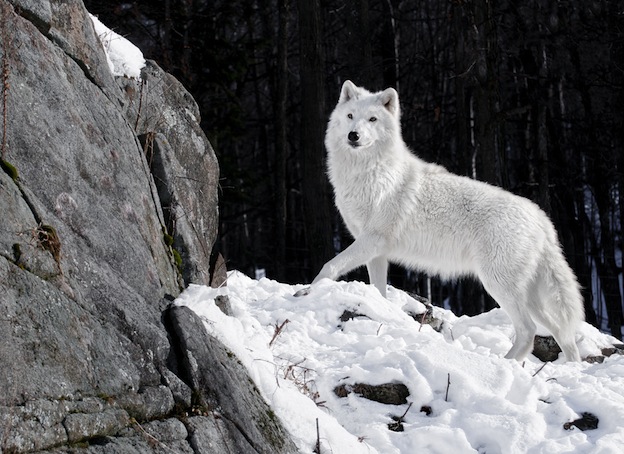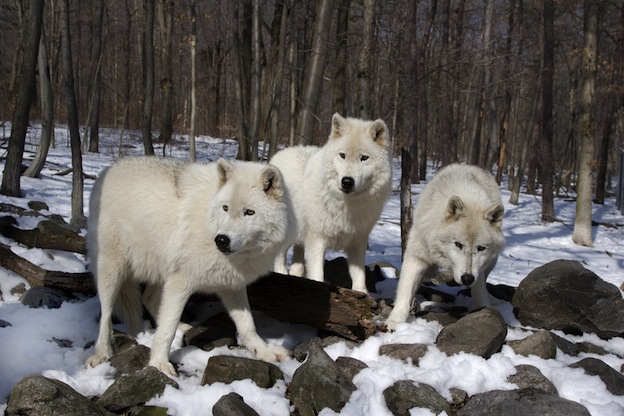Arctic Wolf – Canis lupus arctos
Description
No other wolf in the world can offer the same coloring as the Arctic Wolf. It is very unique due to the location where it is found. While some species of wolves do have some white coloring, this one is almost completely white. They do offer some aspects of yellow, gray, and black in places though.
The overall size of them will depend on where they happen to live in their region. Some of them only weight about 75 pounds. Others though can weigh up to 125. Some of them are about 3 feet in length when they are fully grown. Others are twice that long though at about 6 feet.
Anatomy
Due to the extreme cold where the Arctic Wolf lives, they have two thick layers of fur. The outer layer actually gets thicker as the winter months come along. They first layer helps to form a waterproof barrier for the skin. As a result their body temperature can stay warm enough even when it is bitter cold.
These wolves also have smaller ears than other species. That is part of them staying warm as well. They also help them to regular their overall body temperature. Since the ground is permanently frozen they have padded paws that are designed to offer them a good grip when they walk.
Evolution
The information about the evolution of the Arctic Wolf continues to be debated among the experts. It is believed by most they that evolved from other types of canines more than 50 million years ago. It is also believed that due to the Ice Age some wolves ended up in this very cold region.
They were able to develop an anatomy that allowed them to adapt to the extremely cold temperatures. They also learned how to survive on fat stored in the body instead of needing food as often as other species of wolves do.

Behavior
Some people believe that the Arctic Wolf is a loner by nature but that isn’t true. Those that are seen alone may be away from their pack to search for food. They can also be on their own looking to make their own pack. The size of these groups can be from just a couple of wolves to about twenty. Generally the size of the pack will depend on how much food happens to be available to them.
These wolves happen to be very territorial. However, most of them do have hundreds of miles that they can cover within their home range. As a result of this they don’t really mind so much when other packs have a territory that overlaps. They do heavily mark their territory though with urine and their own scent.
Habitat/Distribution
Alaska is where the majority of the wild Arctic Wolves live. They are able to walk on the frozen ground due to the way their feet are designed. That allows them to shift their weight around and to keep a good grip. Not only can they stand the very cold temperatures, they don’t seem to mind the part of the year when it is dark for both day and night.
Both Greenland and Canada have Arctic Wolves that are found in various locations as well. However, the numbers of them in these areas are drastically low. They have moved or they have perished due to a lack of food and habitat for them to survive. Around Alaska the natural habitat for these wolves has been untouchable due to the land being too cold for people to thrive in.
Diet/Feeding Habits
Due to the location of the Arctic Wolf, they are very limited when it comes to the supply of food they can consume. Generally they will eat caribou and muskoxen. Since these animals are much larger than they are, it is a group effort to successfully take one down. Even though they are great hunters, their prey can often get away before they can attack from all sides.
When they do make contact though they will be successful. Arctic Wolves have very sharp teeth as well as powerful jaws. They are able to rip into the flesh and crunch the bones of the animals they capture. They can eat more than 20 pounds of meat at a time. They often know that it may be a while before their next meal so they will consume all that they possibly can when it is readily available to them.
Due to the freezing cold, a large animal that they kill may offer enough food for the entire wolf pack for several days. When that is the case they will take turns feeding and also protecting the kill from other animals. There are other times though when they must go for weeks without much food at all. It may also be necessary for them to move according to the movements of their prey. Otherwise the risk of not finding a meal soon enough becomes reality.
For the young pups that are outside of the mother’s den but aren’t old enough to hunt yet, they still need meat. In order to get it, the other members of the pack will offer them regurgitated meat that they have partially consumed.

Reproduction
As is the case with most species of wolves, only the alpha male and the beta female will be allowed to mate. That is often the reason why younger wolves about two years of age head out on their own. The urge to mate is very common and it will encourage them to make their own pack where they can mate.
The pups are born a couple of months after mating. About a month after mating the female will start to find a place where she can give birth. Often she will spend a great deal of time digging in the layers of ice to make a den. Sometimes it will prove to be too difficult though. Then she will have to find a den that is already in place, rocks, or even a cave where she can give birth.
It is very important that she has safe place for the young to be born. She can have up to twelve of them at once to care for. They are about one pound when they are born. They can’t hear or see so they rely upon instinct and smell to survive in her care for the first couple of months of life.
She will need to leave them from time to time so she can go get food for herself. This can leave the young pups very vulnerable at that time. When they are approximately three months old they will join the rest of the pack with her. The entire pack will do what they can to help ensure these young are able to survive.
Predators
Due to the isolated areas where the Arctic Wolf lives, they don’t have too many problems with predators. Sometimes the young can be eaten by other animals if they wonder out of the den on their own or they venture too far away from the pack. Occasionally battles with other packs can occur due to problems arising. This often involves a fight for territory, food, or mating rights.







